Free download: Top 10 Natural & Easy Remedies for Joint Pain from Home. Learn these helpful remedies.
Estimated Reading Time: 11 minutes read
We’ve all read articles on tips for falling asleep and getting better sleep at night. Those lists often cover stopping screen time early, going to bed at a similar time each night and more, but they don’t address how to fall asleep when your knee pain is worse at night.
When we have knee pain it’s not as simple as turning your phone off or going to bed at 9 PM every night.
You can do everything right, but if you have knee pain, it can be really challenging to not only fall asleep but stay asleep.
In this article, we’ll discuss why knee pain can feel worse at night as well as ways to help with knee pain so that you can actually get better sleep.
Table of Contents
What Causes Knee Pain at Night?
You aren’t imagining your knee pain being worse at night. There are several reasons pain levels increase at night and make it harder to sleep.

Inflammation
Inflammation occurs when your body is fighting off something in your system. While this is meant to help your body heal, inflammation causes pain and discomfort and can sometimes linger, becoming chronic inflammation.
You feel the effects of inflammation at night because our body naturally produces less Cortisol, an anti-inflammatory hormone at night. This ultimately means: less cortisol at night = more pain at night.

Lack of Movement
During the day we move around. This makes our joints happy because it keeps fluid moving in the body and keeps everything lubricated.
When we move less at night that fluid that was moving around in our body tends to pool in our joints.
This increases pressure and pain in our joints and is why we feel much stiffer in the morning when you first wake up.

Less Distraction
While there are many positives to giving your brain a break from distractions when trying to fall asleep, when it comes to pain less distractions can sometimes make things worse.
During the day we are focused on work, hobbies, chores, and more that take at least some focus away from our pain.
However, at night we don’t have those distractions so it can be more challenging to let your mind drift off to sleep when knee pain is shouting at you.

Position
While we normally think of our bed as the most comfortable place in our home, laying down can sometimes increase pain levels.
In particular with knee pain, you may find that your pain increases when you lay on your back and your knee is fully extended. Or, you may find that your knee pain increases when you lay on your painful side.
We often have a favorite sleeping position and it can be quite challenging when your favorite position increases knee pain.
Preventive Measures To Reduce Pain During the Day
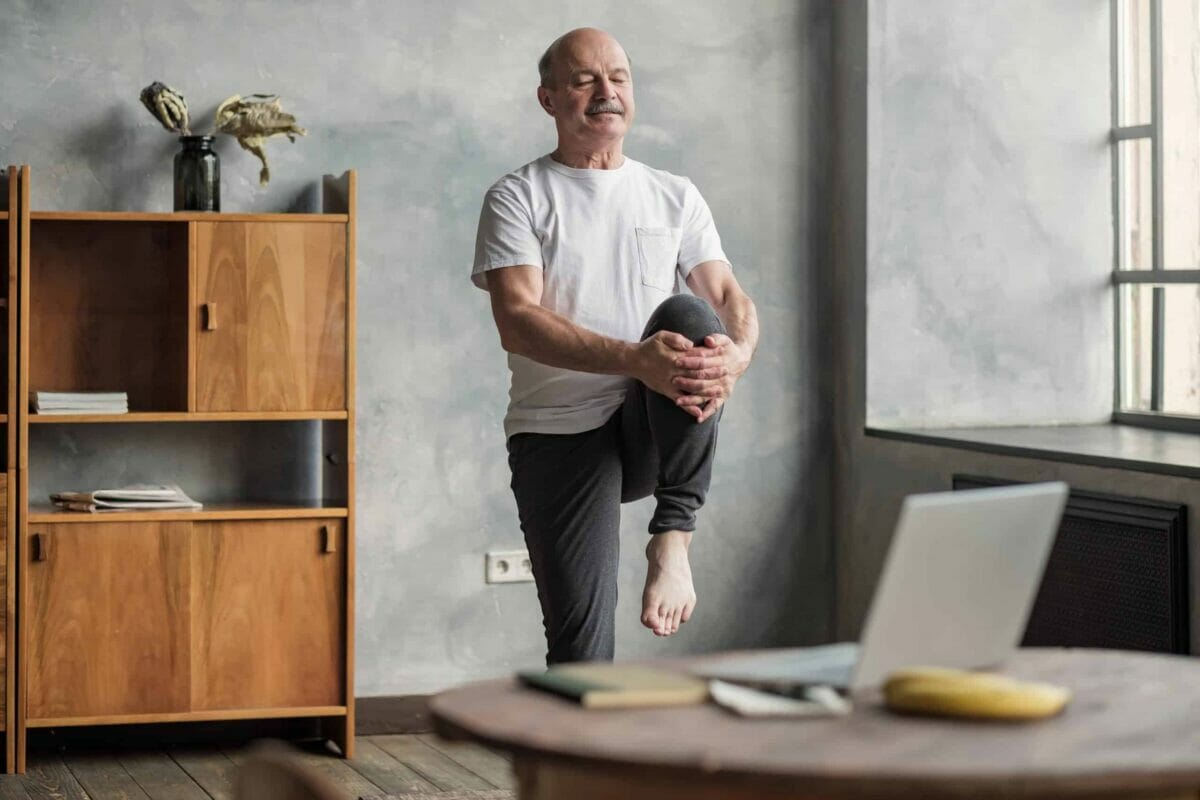
While there are reasons you experience more pain at night, you can start taking proactive steps to help night pain during the day.
As we’ve discussed, you are more prone to experiencing knee pain at night due to a drop in the anti-inflammatory hormone Cortisol that naturally occurs each night.
We can plan for this by taking steps to lower your inflammatory levels during the day:
Wear a knee brace when performing activities that are known to increase your knee pain.
Pay attention to your knees when lifting heavy objects. Make sure your knees don’t move past your toes when lifting, this increases pressure and therefore inflammation in your knees. (perfect to link to the optimized squat article!)
Stretch and warm up your legs in the morning when you are stiff. Warming up your legs is also good to keep in mind before performing higher energy activities.
Be mindful of overuse of your knee. Some jobs, hobbies, activities have a lot of repetitive knee motions that might be increasing inflammation.
Take breaks if possible and look into ways to potentially modify your activity to reduce overuse.
If you’re starting a new exercise routine or progressing a routine pay attention to knee pain and make sure you are progressing exercise slowly.
It can be really tempting to add and extra mile to your run or quickly increase weights when lifting, but remember to be mindful of making smaller gradual changes to prevent more inflammation in your knees.
Don’t forget that the shoes you wear impact your knees. Wearing heels, flip flops, or unsupportive shoes not only affect your feet and ankles, but also impact the way you walk and move.
This directly impacts your knees and may be adding to inflammation and knee pain. Don’t forget that even supportive shoes like sneakers should be replaced every 300-500 miles, which is roughly every three months.
Be mindful of how you sit during the day. Sitting with your legs crossed or your knees folded under you increases pressure on those joints!
If you have had a healthcare provider recommend you use an assistive device, use it. Using an assistive device can sometimes feel like a lot more work; however, if you have had one recommended to you it’s usually to help you walk with improved gait mechanics and balance.
The better you walk, the less pressure you have on your knees.
If you take anti-inflammatories it’s better to stay ahead of the pain. Speak to your primary care physician before changing your medication plan.
In general, however, if you are cleared it’s better to take anti-inflammatories to stay ahead of pain, rather than waiting till pain levels are high.
For example, taking pain medication when your pain is at a 4/10 rather than waiting till 7/10 or higher.
Quit smoking. Smoking reduces circulation and delays healing, which may lead to increased inflammation and knee pain.
Get a massage. Massage is a great way to reduce stress and improve muscle stiffness that may be impacting your knee pain.
Plan for Inflammation at Night
After being kind to your knees during the day, here are some tips for continuing to set yourself up for success with knee pain at night.
Stretch and move your knee before bed. In general, motion is lotion when it comes to our joints so performing some gentle knee movements and stretches can help get fluids moving in your body rather than pooling in your knees and causing more pain.
Apply ice or heat prior to bed. Use the tools that have worked for you in the past to help with knee pain.
Use them to help reduce inflammation or stiffness right before bed to help keep pain levels low while trying to fall asleep.
If recommended by a healthcare provider, use compression socks. These can help with swelling in your knee and legs with in turn helps reduce inflammation and pressure in the knee joint.
Use a pillow to aid with knee pain associated with the position you are laying in. You can place a pillow under your knees when laying on your back or between your knees when laying on your side to reduce pressure.
However, if you just had a total knee replacement in the last few weeks do not sleep with a pillow under your knees! While it helps with pain you are currently working on gaining knee extension and sleeping with a pillow under your knee could limit that.
Just like during the day: if you take anti-inflammatories it’s better to stay ahead of the pain. Speak to your primary care physician before changing your medication plan.
In general, however, if you are cleared it’s better to take anti-inflammatories to stay ahead of pain, rather than waiting till pain levels are high.
For example, taking pain medication before going to bed to keep knee pain down rather than waiting till you’ve been lying awake for several hours due to pain.
Is Exercise Helpful or Should I Rest my Knee?
If you experience knee pain at night, that means you probably experience knee pain with exercises as well. It might feel counterintuitive, but exercising with pain may help actually reduce pain.
Overall, exercise reduces swelling and stiffness in joints which can improve pain. Additionally, strengthening the muscles around the knee helps stabilize and support the knee so there is less inflammation and pain as well.
Another bonus is that exercise can help maintain your knee range of motion which can help with positional tolerance at night and during the day.
Keeping up with swelling, pain, range of motion, and strength also plays into being able to walk without a limp and perform activities without impairments.
The better we move, the less pressure we have on our knees or other joints and the better we feel overall.
General exercise guidelines are to aim for 30 minutes of activity five days a week. If 30 minutes seems like too much right now, the recommendations also support breaking that 30 minutes into three ten minute segments.
If you experience significant pain when walking or notice pain increase significantly after exercising it may be time to reach out to your primary care physician to see about treatment options.
How To Relieve Knee Pain At Night with 3 Exercises
Here are three exercises you can perform before bed to help with knee mobility and pain. An added bonus is that these can all be formed in bed as well!
1. Seated leg extension
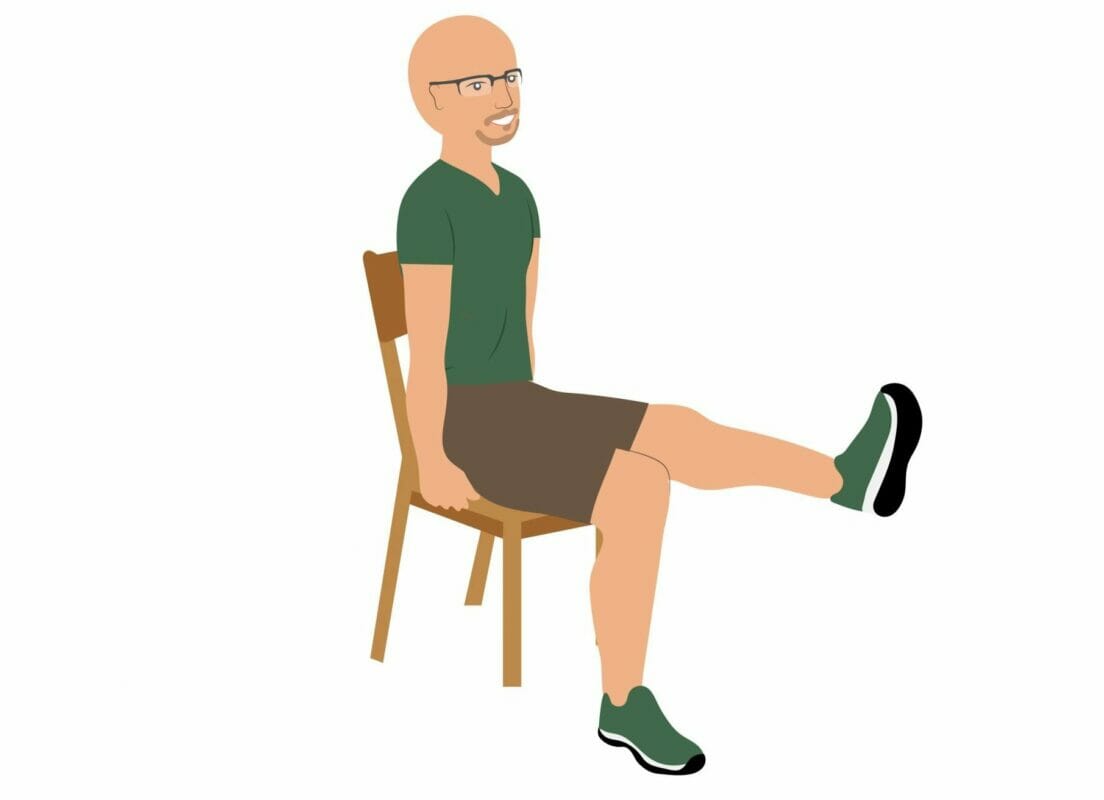
This exercise will have you feeling a little like a Rockette Dancer, although, don’t worry you won’t be kicking your leg out as high as they do!
Start by sitting on the edge of your bed. Then extend one of your knees until your leg is straight. Then allow your knee to bend again, keeping control as your knee bends rather than just letting your foot just drop back down.
Repeat 10 times, then switch legs and perform 10 times on the other leg. Repeat that set of 10 three times on each side to get the fluid in your knees moving before bed.

2. Seated Towel/Pillow Presses

Start by sitting up or laying (whichever feels best for your back) in bed and extending your legs out straight.
Grab either a pillowcase or rolled hand towel. Place the item under one leg, directly behind the knee. Rest your back against the headboard or lean back onto your hands if needed to better support your back.
While keeping good posture, press your knee into the towel/pillowcase for 10 seconds before relaxing. Think of it as trying to crush the towel/pillowcase under your knee.
Repeat 3 times on the same leg then switch!

3. Heel Slides
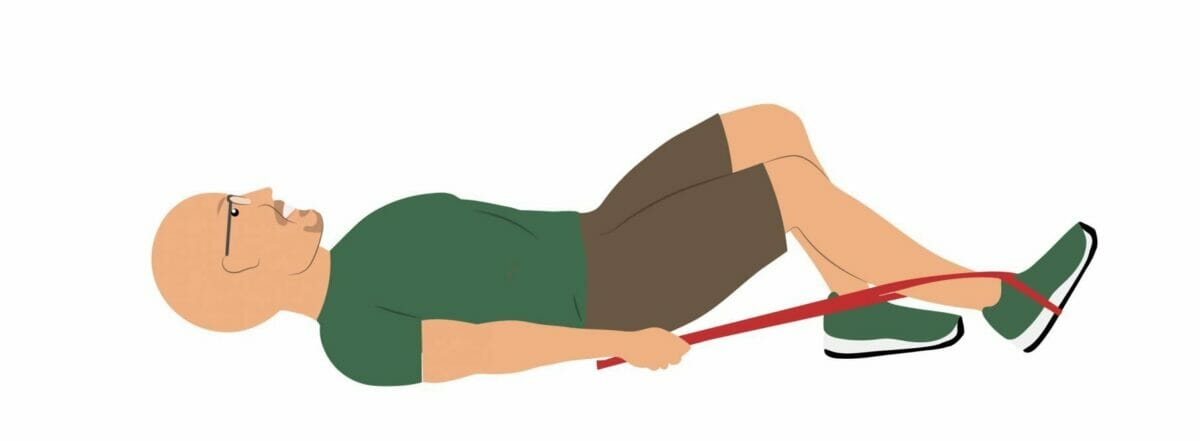
We covered extending your knee in the last two exercises, which means there is only one more exercise to go: bending your knee.
For this grab a dog leash, belt, or rope. Begin by laying on your back and looping the rope around your foot.
Next you will slowly bend your knee using your arms to pull the rope tighter as your knee keeps bending. Pulling the rope with your arms allows you to bend your knee and increase your range of motion outside of your comfort zone.
This one may be a little uncomfortable but shouldn’t cause significant pain. Hold your knee in that bent position for two seconds, then slowly take the pressure off and straighten your leg back out.
Repeat this ten more times. If you have pain in both knees, perform this on your other knee 10 times as well.
If the pain gets worse during or after exercise, you should consider:
If you notice pain with activity the first step is to lower the intensity of the exercise. Reduce the amount of time, reps, speed, or weight to take some pressure off your knee.
If you think pain might be due to your exercise form, then reach out to a physical therapist or personal trainer to make sure you’re performing exercises correctly.
You may be surprised to find that the way you’re performing a squat or lifting is actually contributing to your knee pain.
If you continue to have significant knee pain at night after consistently exercising, adjusting your workout routine, and after checking your form it may be time to speak to your primary care physician. They can help direct you on a treatment plan and treatment options.
Sleep is critical for physical and mental health so it’s important to take steps now to help with knee pain at night so you can get back to feeling like yourself again!


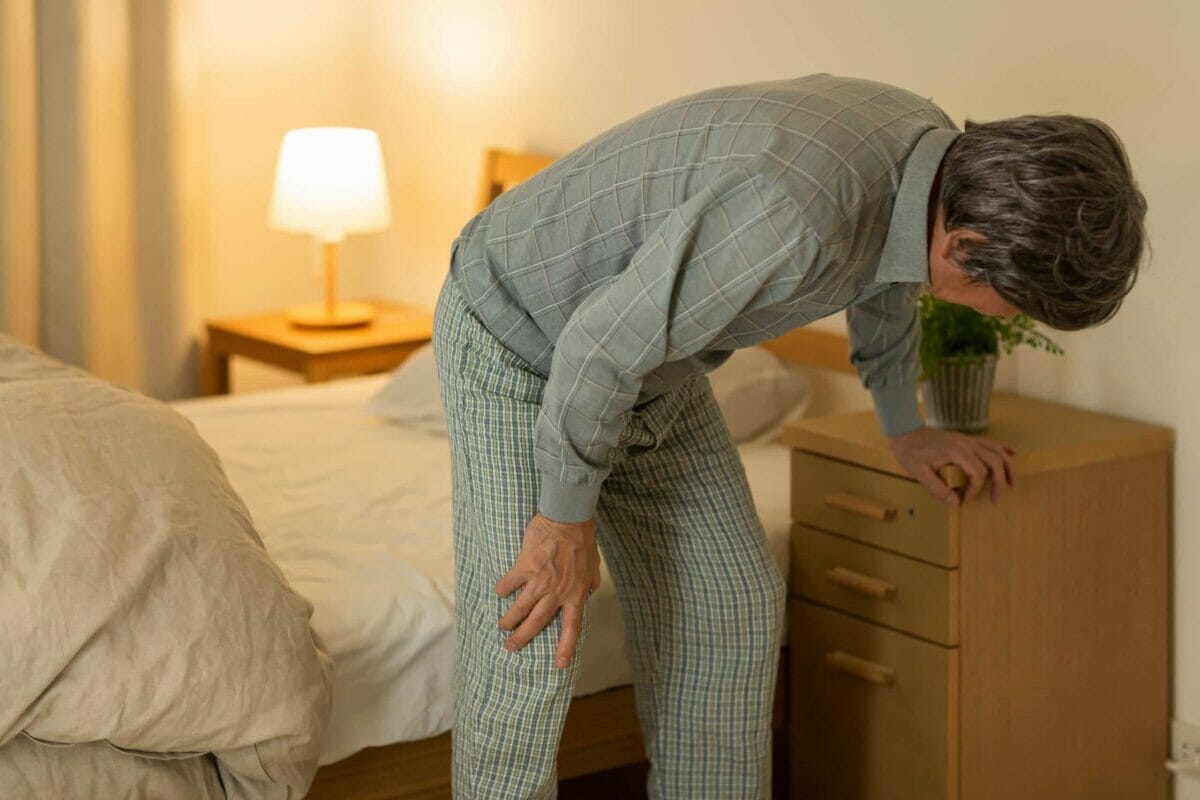







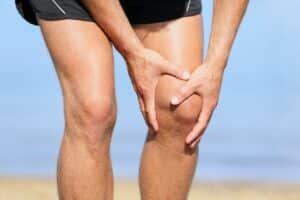
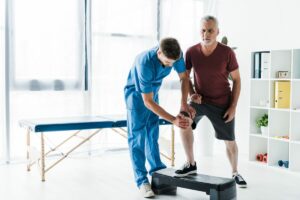

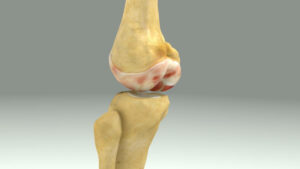


12 Responses
i have been thinking about this knee pain problem from many days
Thank you
You're welcome!
Sometimes I and just sitting and I will get a sharp pain on the inside of one of my knees. Sometimes I also get a pain up and over my knee.
It feels Mike like a nerve pain rather than a joint pain because I had no weight on it and was not moving. What exercises do you recommend?
I would definitely recommend checking out our Feel Good Knees program!
Thank you for the advise. Is there anyway to get a hard copy of this routine?
Darrel, we don't have a hard copy available. However, you may print the webpage to have these exercises with you on paper. Hope this helps!
I received my book today.Thank you.My knee can be good for weeks and then suddenly it feels like someone stuck me with a knife and I don’t know why.Happy to have a plan.
Candy, that's exciting! I'm happy that you received your book, and I hope it has helped relieve some of that knee pain.
Great advice - and it works! Thank you, good sir!
You are so welcome, Jerry! I am happy to hear it is working for you.
Thank you for all your advise!!
You're welcome, Ursula! Thank you for reading.